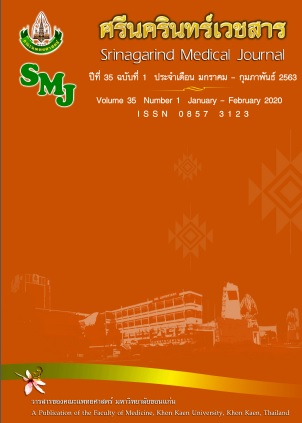Level of Knowledge in Self-measured Blood Pressure Monitoring Among Family Physicians in Thailand
Keywords:
self-measured blood pressure (SMBP), level of knowledge, family physicians, การวัดความดันโลหิตด้วยตัวเองที่บ้าน, ระดับความรู้, แพทย์เวชศาสตร์ครอบครัวAbstract
ระดับความรู้เรื่องการวัดความดันโลหิตด้วยตัวเองที่บ้านของแพทย์เวชศาสตร์ครอบครัวในประเทศไทย
อรณิสา อิสสรานนท์1, เรือนขวัญ กัณหสิงห์1*, สวณี เต็งรังสรรค์2
1 สาขาเวชศาสตร์ครอบครัว คณะแพทยศาสตร์ มหาวิทยาลัยธรรมศาสตร์
2 สาขาเวชศาสตร์ชุมชน คณะแพทยศาสตร์ มหาวิทยาลัยธรรมศาสตร์
หลักการและวัตถุประสงค์: ผู้ป่วยความดันโลหิตสูงควรวัดความดันโลหิตด้วยตนเองที่บ้านโดยได้รับคำแนะนำที่ถูกต้องจากบุคลากรสุขภาพ แต่ยังไม่พบข้อมูลเกี่ยวกับระดับความรู้ของแพทย์เวชศาสตร์ครอบครัว การศึกษานี้จึงมีวัตถุประสงค์เพื่อศึกษาระดับความรู้ และปัจจัยที่มีความสัมพันธ์กับระดับความรู้เรื่องการวัดความดันโลหิตด้วยตัวเองที่บ้านของแพทย์เวชศาสตร์ครอบครัว
วิธีการศึกษา: เป็นการศึกษาเชิงพรรณาแบบภาคตัดขวางในแพทย์เวชศาสตร์ครอบครัวที่มีชื่อในทะเบียนของราชวิทยาลัยแพทย์เวชศาสตร์ครอบครัว ณ ปี พ.ศ. 2560 ใช้แบบสอบถามโดยให้ตอบเอง วิเคราะห์ข้อมูลด้วยสถิติเชิงพรรณาและสถิติไคสแควร์ แบ่งระดับความรู้เป็น 3 ระดับ คือ ความรู้ระดับดี (คะแนนตั้งแต่ร้อยละ 80 ขึ้นไป) ปานกลาง (คะแนนร้อยละ 60-79.99) และต่ำ (คะแนนต่ำกว่าร้อยละ 60)
ผลการศึกษา: มีผู้เข้าร่วมวิจัย 172 ราย เป็นเพศหญิง ร้อยละ 59.3 ช่วงอายุ 30-39 ปี ร้อยละ 56.98 ให้แนะนำผู้ป่วยอย่างสม่ำเสมอในการวัดความดันโลหิตด้วยตัวเองที่บ้านร้อยละ 38.95 ผู้เข้าร่วมวิจัยส่วนมาก ร้อยละ 79.07 มีความรู้อยู่ในระดับต่ำ โดยปัจจัยต่าง ๆ ได้แก่ เพศ อายุ อายุการทำงาน สถานที่ทำงาน การเคยรับการอบรมเรื่องความดันโลหิตสูง และความถี่ในการให้แนะนำ ไม่มีความสัมพันธ์กับระดับความรู้อย่างมีนัยสำคัญทางสถิติ
สรุป: แพทย์เวชศาสตร์ครอบครัวส่วนมากมีความรู้เรื่องการวัดความดันโลหิตด้วยตัวเองที่บ้านระดับต่ำ และไม่พบปัจจัยที่มีความสัมพันธ์กับระดับความรู้อย่างมีนัยสำคัญทางสถิติ
Background and Objectives: Self-measured blood pressure (SMBP) should be advised by health professionals for hypertensive patients. However, there is no study of level of knowledge of family physicians (FPs). This study aimed to explore the level of knowledge of SMBP among FPs and its associated factors.
Methods: A cross-sectional descriptive study was conducted in FPs whose names appear in the 2017 registry of the Royal College of Family Physicians of Thailand. A self-administered questionnaire was utilized. Descriptive statistics and chi-squared test were used for data analysis. The level of knowledge is classified into three levels: high (score 80% and above) moderate (score 60%-79.99%), and low (score less than 60%).
Results: Of 172 FPs who participated, 59.3 % were female, and age between 30-39 years old was 56.98%. Only 38.95% of FPs advised on SMBP regularly. The majority of participants (79.07%) have a low level of knowledge on SMBP. There is no statistically significant relationship between the level of knowledge and these factors include gender, age, years after MD, work settings, training for treatment of hypertension, and frequency of advice SMBP.
Conclusion: Most FPs have a low level of knowledge on SMBP, and there is not any factor in this study was associated with physicians’ level of knowledge.
References
Campbell NR, Lackland DT, Niebylski ML. High blood pressure: why prevention and control are urgent and important: a 2014 fact sheet from the World Hypertension League and the International Society of Hypertension. JCH 2014.
Kochanek KD, Xu J, Murphy SL, Minino AM, Kung HC. Deaths: final data for 2009. Natl Vital Stat Rep. 2011;60 :1-116.
อัจฉรา ภักดีพินิจ, ศกลวรรณ แก้วกลิ่น และสุภาพร พรมจีน. ประเด็นสารรณรงค์วันความดันโลหิตสูงโลก ปี 2559 [อินเทอร์เน็ต]. กรุงเทพฯ: สำนักโรคไม่ติดต่อ กรมควบคุมโรค; 2559 [เข้าถึงเมื่อ 28 มีนาคม 2561]. เข้าถึงได้จาก http://www.thaincd.com/document/file/info/non-communicable-disease/%E0%B8%9B%E0%B8%A3%E0%B8%B0%E0%B9%80%E0%B8%94%E0%B9%87%E0%B8%99%E0%B8%AA%E0%B8%B2%E0%B8%A3%E0%B8%A3%E0%B8%93%E0%B8%A3%E0%B8%87%E0%B8%84%E0%B9%8C%E0%B8%A7%E0%B8%B1%E0%B8%99%E0%B8%84%E0%B8%A7%E0%B8%B2%E0%B8%A1%E0%B8%94%E0%B8%B1%E0%B8%99%E0%B9%82%E0%B8%A5%E0%B8%AB%E0%B8%B4%E0%B8%95%E0%B8%AA%E0%B8%B9%E0%B8%87%E0%B8%9B%E0%B8%B52559.pdf
Chobanian AV, Bakris GL, Black HR, Cushman WC, Green LA, Izzo JL, Jr., et al. The Seventh Report of the Joint National Committee on Prevention, Detection, Evaluation, and Treatment of High Blood Pressure: the JNC 7 report. Jama 2003;289 :2560-72.
National Institute for Health and Care Excellent. Hypertension in adults: diagnosis and management [Internet]. 2019 [cited 5 Oct 2019]. Available from https://www.nice.org.uk/guidance/ng136/chapter/Recommendations#measuring-blood-pressure
Leung AA, Nerenberg K, Daskalopoulou SS, McBrien K, Zarnke KB, Dasgupta K, et al. Hypertension Canada's 2016 Canadian Hypertension Education Program Guidelines for Blood Pressure Measurement, Diagnosis, Assessment of Risk, Prevention, and Treatment of Hypertension. Can J Cardiol 2016;32 :569-88.
Parati G, Stergiou GS, Asmar R, Bilo G, de Leeuw P, Imai Y, et al. European Society of Hypertension practice guidelines for home blood pressure monitoring. J Hum Hypertens 2010; 24 : 779-85.
Centers for Disease Control and Prevention. Self-Measured Blood Pressure Monitoring: Action Steps for Public Health Practitioners. Atlanta, GA: Centers for Disease Control and Prevention, US Dept of Health and Human Services; 2013.
Sharman JE, Howes FS, Head GA, McGrath BP, Stowasser M, Schlaich M, et al. Home blood pressure monitoring: Australian Expert Consensus Statement. J Hypertens 2015; 33 :1721-8.
สมาคมโรคความดันโลหิตสูงแห่งประเทศไทย. แนวทางการรักษาโรคความดันโลหิตสูงในเวชปฏิบัติทั่วไป (ฉบับปรับปรุง พ.ศ.2558) [อินเทอร์เน็ต]. 2558 [เข้าถึงเมื่อ 28 มีนาคม 2561]. เข้าถึงได้จาก: http://www.thaihypertension.org/files/GL%20HT%202015.pdf
Gelfer M, Dawes M, Kaczorowski J, Padwal R, Cloutier L. Diagnosing hypertension: Evidence supporting the 2015 recommendations of the Canadian Hypertension Education Program. Can Fam Physician 2015; 61 :957-61.
Petrella RJ. Moving Forward: Family Physicians & Hypertension. Perspectives in Cardiology. 2004.
Kaczorowski J, Myers MG, Gelfer M, Dawes M, Mang EJ, Berg A, et al. How do family physicians measure blood pressure in routine clinical practice? National survey of Canadian family physicians. Can Fam Physician 2017; 63 :e193-e9.
Obara T, Ohkubo T, Fukunaga H, Kobayashi M, Satoh M, Metoki H, et al. Practice and awareness of physicians regarding home blood pressure measurement in Japan. Hypertens Res 2010; 33 :428-34.
Baral-Grant S, Haque MS, Nouwen A, Greenfield SM, McManus RJ. Self-Monitoring of Blood Pressure in Hypertension: A UK Primary Care Survey. Int J Hypertens 2012; 2012.
Levy J, Gerber LM, Wu X, Mann SJ. Nonadherence to Recommended Guidelines for Blood Pressure Measurement. J Clin Hypertens (Greenwich) 2016; 18 :1157-61.
Tirabassi J, Fang J, Ayala C. Attitudes of primary care providers and recommendations of home blood pressure monitoring--DocStyles, 2010. J Clin Hypertens (Greenwich) 2013; 15 : 224-9.


